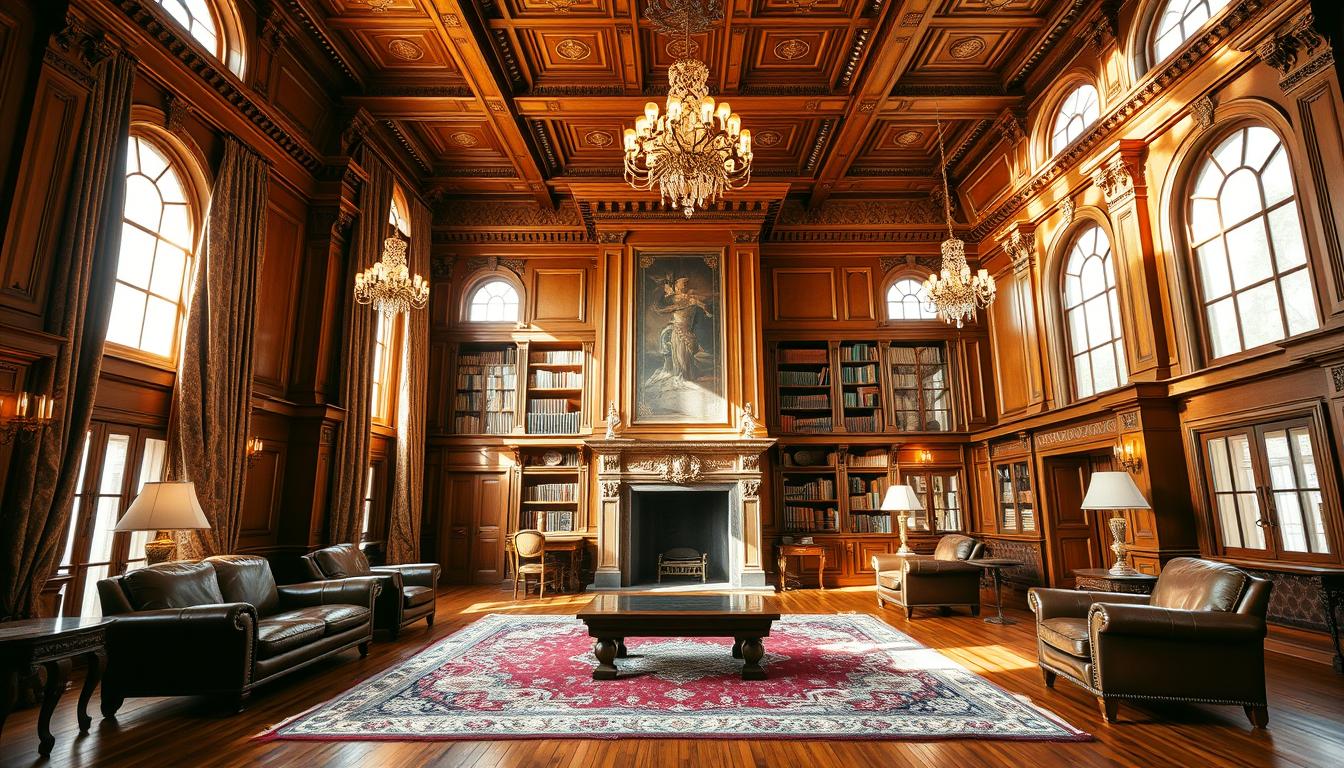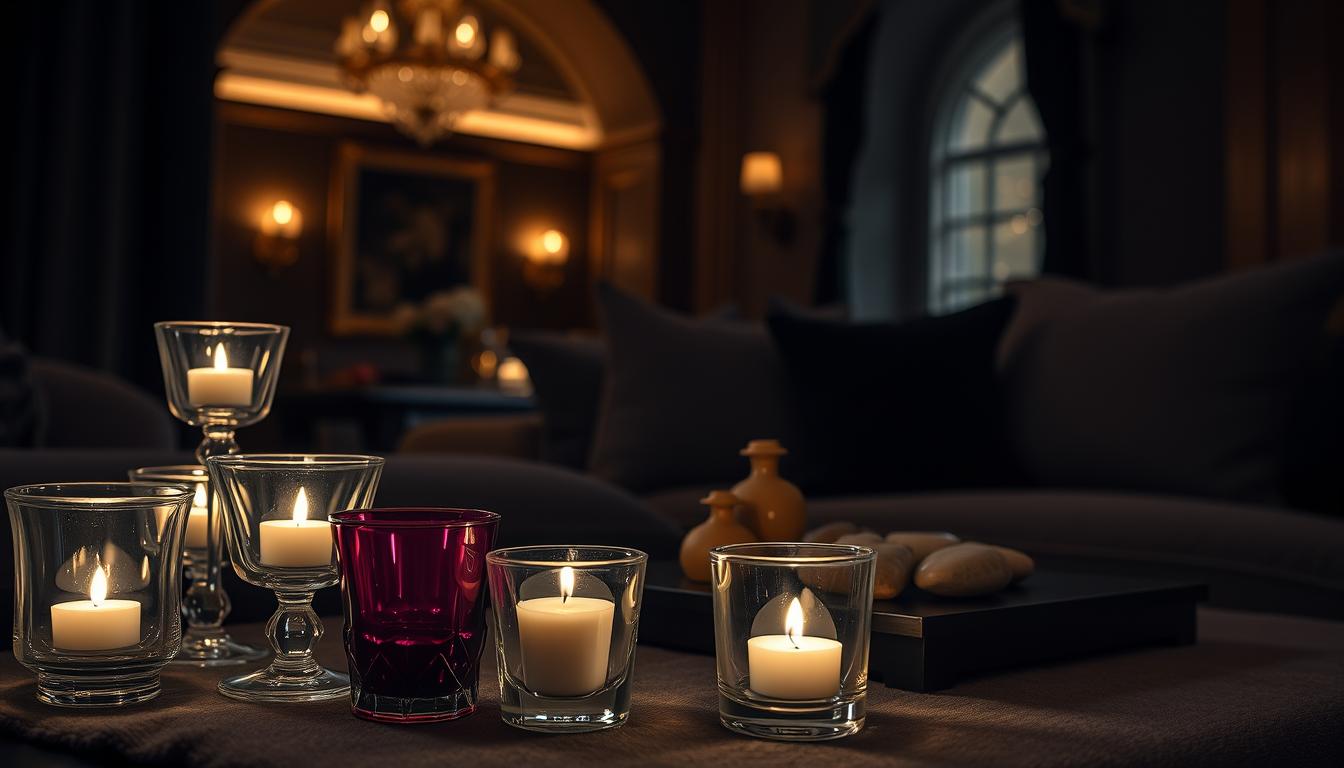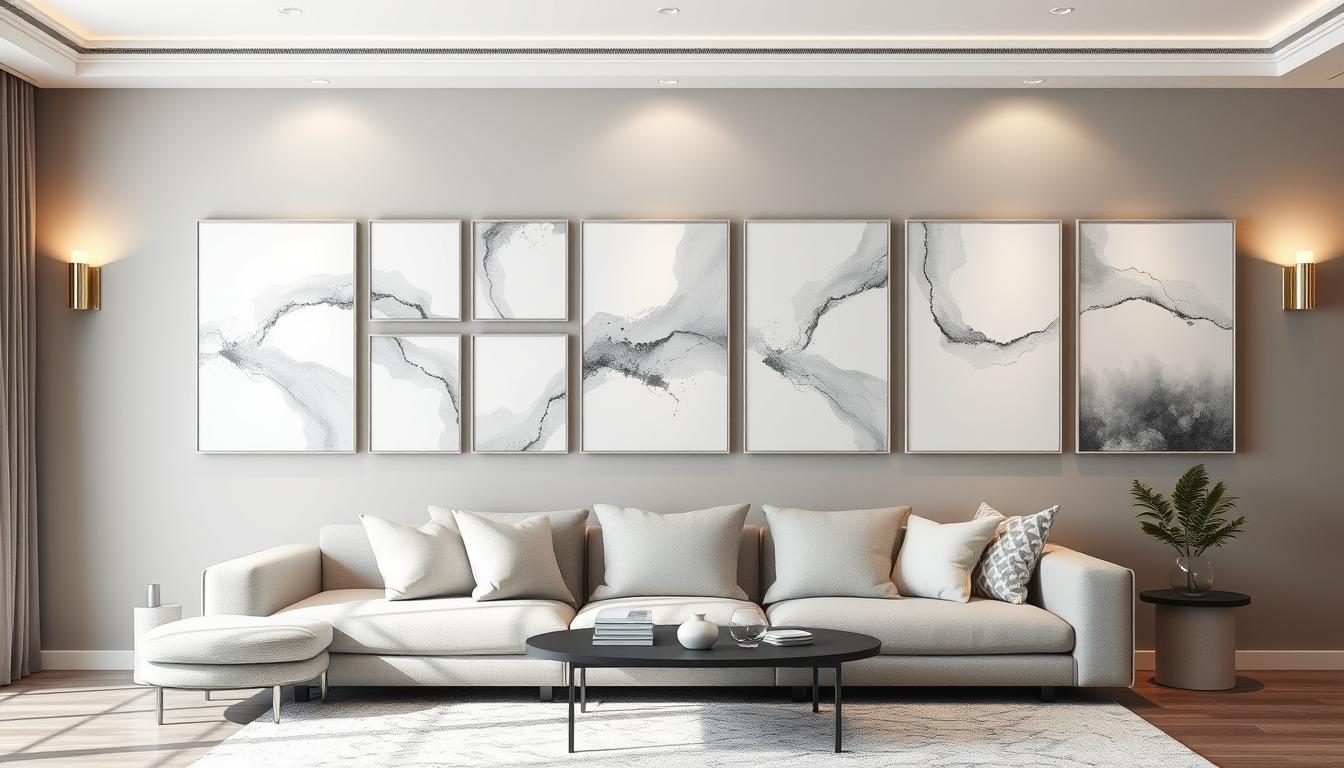Did you know colonial-style homes are still a top choice in the U.S.? This style brings a timeless charm with classic elements. It’s all about history and tradition. Let’s dive into colonial decorating and see what makes it special.
We’ll show you how to add colonial style to your home decor. You’ll learn about furniture, colors, and textiles. We’ll give you all the tips to decorate your space beautifully.
Key Takeaways
- Understanding the classic elements of colonial style
- Selecting furniture that fits the colonial aesthetic
- Choosing appropriate color palettes and textiles
- Tips for incorporating colonial style into your decor
- Creating a cohesive and inviting space
What Defines Colonial Style in Interior Design?
Exploring colonial style interior design takes us back to the 17th and 18th centuries. It’s about the architectural and decorative traditions of European settlers in America.
Historical Overview of Colonial Homes
Colonial homes have a rich history. They show the cultural and architectural influences of early European settlers. These homes are known for symmetry, classic proportions, and traditional materials.
They were built to be functional, comfortable, and show the owner’s social status. The colonial period in America saw different architectural styles. These include Georgian, Dutch Colonial, and Spanish Colonial, each with its own features but all valuing classic design.
Key Features of Colonial Interior Design
Colonial interior design stands out with classic furniture pieces, traditional color palettes, and ornate textiles. Furniture was crafted from solid woods like oak and maple. It had intricate carvings and upholstery that showed the era’s craftsmanship.
Color schemes were calm, with earth tones, blues, and reds from natural dyes. Textiles were key, with fabrics featuring intricate patterns. These added warmth and character to the interiors.
By understanding these historical and design elements, we can see why colonial style is still loved today. It continues to shape interior design.
Key Elements of Colonial Style Decor
To decorate your home in colonial style, it’s key to know the core elements. Colonial style decor is more than just historical designs. It’s about making a warm, inviting, and elegant space that values traditional craftsmanship and beauty.
Furniture Selection: Classic Choices
Colonial style is known for its classic furniture. Chippendale chairs and four-poster beds are must-haves, with their detailed carvings and strong build.
When picking furniture for a colonial-style home, look for pieces that show 18th-century craftsmanship. Here are some tips:
- Choose furniture made from solid hardwoods like oak, maple, and cherry.
- Look for pieces with intricate carvings and ornate details.
- Opt for classic designs that have evolved over time.
Color Palettes: Traditional Hues
The color palette in colonial-style homes is muted and earthy. It reflects the natural dyes of the colonial period.
Traditional colors include:
- Muted reds, such as brick red and burgundy.
- Deep blues, like navy and royal blue.
- Soft yellows and golden tones.
These colors create a warm and welcoming feel in the home.
Textiles and Patterns: Fabrics That Fit
Textiles are vital in colonial-style decor. Fabrics like velvet, linen, and cotton are used a lot.
“The choice of fabric can greatly affect the ambiance of a room, with heavier fabrics like velvet adding a sense of luxury and lighter fabrics like linen providing a more casual feel.”
Patterns like stripes, florals, and damask are common. They’re used in upholstery, drapery, and bedding to add depth and interest.
By focusing on furniture, color palettes, and textiles, you can create a colonial-style home that’s both authentic and welcoming.
Essential Colonial Style Rooms to Design
To achieve an elegant colonial interior design, focus on the living room, dining room, and bedroom. These rooms are the heart of your home. They should reflect the classic charm of colonial style.
Living Room: Creating a Warm Welcome
The living room is where you and your guests will spend a lot of time. It’s essential to make it warm and welcoming. Choose comfortable seating and classic furniture pieces that reflect the colonial era, such as wingback chairs and sofas with intricate carvings.
Consider adding warm-toned wood furniture and rich textiles like velvet or linen. This will enhance the cozy atmosphere. A statement piece, like a beautifully crafted wooden coffee table, can also add to the room’s charm.
Dining Room: Formal Yet Inviting
The dining room should be formal yet inviting, perfect for hosting dinner parties or family gatherings. A large, ornate dining table is a centerpiece, surrounded by chairs that complement its style.
To create an inviting ambiance, consider using a combination of overhead lighting and table lamps. Adding a colonial-style chandelier can also elevate the room’s formality and elegance.
Bedroom: Emphasizing Comfort and Elegance
In the bedroom, the focus should be on comfort and elegance. A four-poster bed is a classic choice, adding a touch of sophistication to the room.
Luxurious textiles, such as silk or high-quality cotton, should be used for bedding and curtains. This will enhance the room’s comfort and visual appeal. Consider adding decorative elements like antique furniture pieces or vintage artwork to complete the colonial look.
By focusing on these essential rooms and incorporating colonial home decorating tips, you can create a home that is both beautiful and functional.
Furniture Selection for Colonial Homes
The furniture in a colonial home is more than just useful. It shows the home’s rich history and style. When picking furniture, look for pieces that match traditional colonial designs, like Queen Anne or Chippendale.
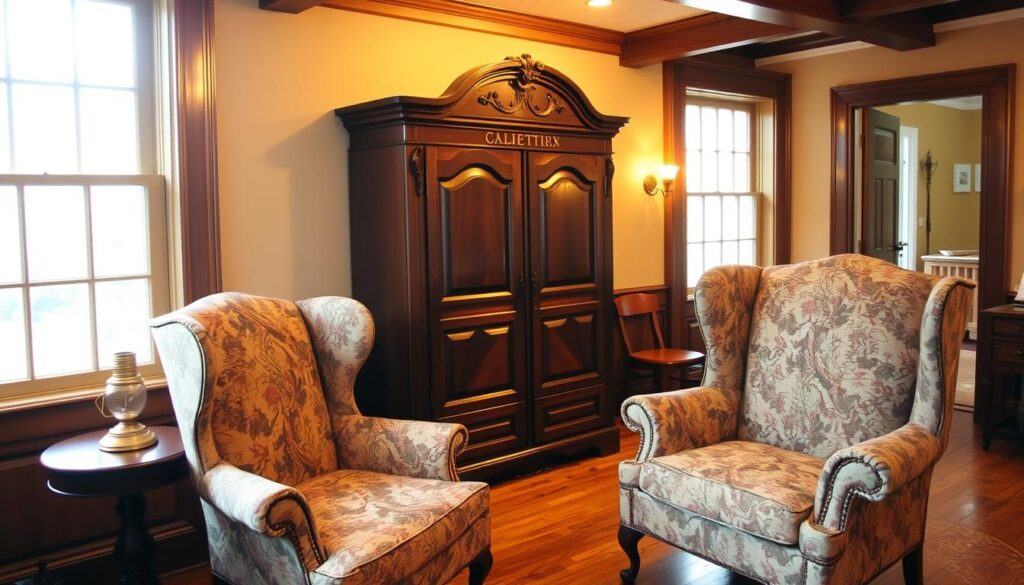
Importance of Authenticity
Authenticity is crucial when choosing furniture for colonial homes. Real colonial-style furniture can make your home look better and feel more complete. Search for items made with old techniques and materials, like solid wood and detailed carvings.
Characteristics of Authentic Colonial Furniture:
- Crafted from solid woods like oak, maple, or cherry
- Intricate carvings and ornate details
- Classic designs inspired by Queen Anne or Chippendale styles
- Timeless elegance that complements colonial home decor
Recommended Brands for Colonial Furniture
Many brands focus on colonial-style furniture, offering a variety of pieces for an authentic look. Some top brands include:
Notable Brands:
- Restoration Hardware: Known for their high-quality, authentic reproductions of colonial furniture.
- Palliser Furniture: Offers a wide range of colonial-style furniture pieces, from sofas to dining tables.
- Universal Furniture: Provides beautifully crafted furniture inspired by traditional colonial designs.
By picking furniture from these brands and focusing on authenticity, you can create a beautiful interior that honors the colonial style.
Color Schemes That Complement Colonial Design
In traditional colonial design, the color palette is key. It makes the home warm and inviting. The right colors can make a colonial style home elegant and welcoming.
Neutral Base Colors: Timeless Choices
Neutral base colors are the heart of a traditional colonial color scheme. Cream, beige, and soft gray are timeless. They let the home’s classic features stand out.
These neutral tones also make it easy to add accent colors. You can use them in furniture, textiles, and decor.
Some popular neutral base colors for colonial style homes include:
- Soft whites and creams
- Muted beiges and taupes
- Gentle grays
Accent Colors: Adding Character
Accent colors bring personality to your colonial style home. Traditional colonial design often uses rich, bold hues like red, blue, and yellow. These colors can be used in furniture, rugs, and decor.
| Accent Color | Traditional Use | Modern Interpretation |
|---|---|---|
| Red | Used in traditional colonial homes to add warmth and energy, often seen in furniture and decor. | Can be used in a more subdued tone to add a touch of sophistication. |
| Blue | Commonly used in colonial design for its calming effect, often in bedrooms and living areas. | Can be paired with neutral tones to create a soothing palette. |
| Yellow | Introduced warmth and optimism, often used in dining rooms and kitchens. | Can be used in brighter shades to add a modern twist. |
By mixing neutral base colors with accent colors, you create a harmonious space. This space honors traditional colonial design while showing your personal style.
Incorporating Textiles in Colonial Style
Adding the right textiles can make your home look elegant like colonial design. Textiles add warmth, texture, and depth to a room.
Choosing the right fabric is key in historical interior design. Fabrics like velvet, linen, and cotton were common in colonial homes. They were used for upholstery, curtains, and bedding. These materials made the rooms look good and feel comfortable.
Choosing the Right Fabrics
Picking the right fabric is important for a true colonial look. Velvet was used for its luxury, while linen and cotton were chosen for their breathability and flexibility.
- Velvet for a luxurious feel
- Linen for its breathability and natural texture
- Cotton for its versatility and durability
Think about the texture, pattern, and color of the fabric. Make sure it matches your colonial furniture and decor.
Popular Textile Patterns in Colonial Homes
Colonial homes often had traditional patterns like stripes, florals, and geometric shapes. These patterns made the rooms interesting and helped tie everything together.
| Pattern | Description | Common Use |
|---|---|---|
| Stripes | Simple, classic design | Upholstery, drapery |
| Florals | Intricate, nature-inspired | Bedding, curtains |
| Geometric | Repeating patterns | Rugs, upholstery |
Using these traditional patterns can make your colonial decor more authentic.
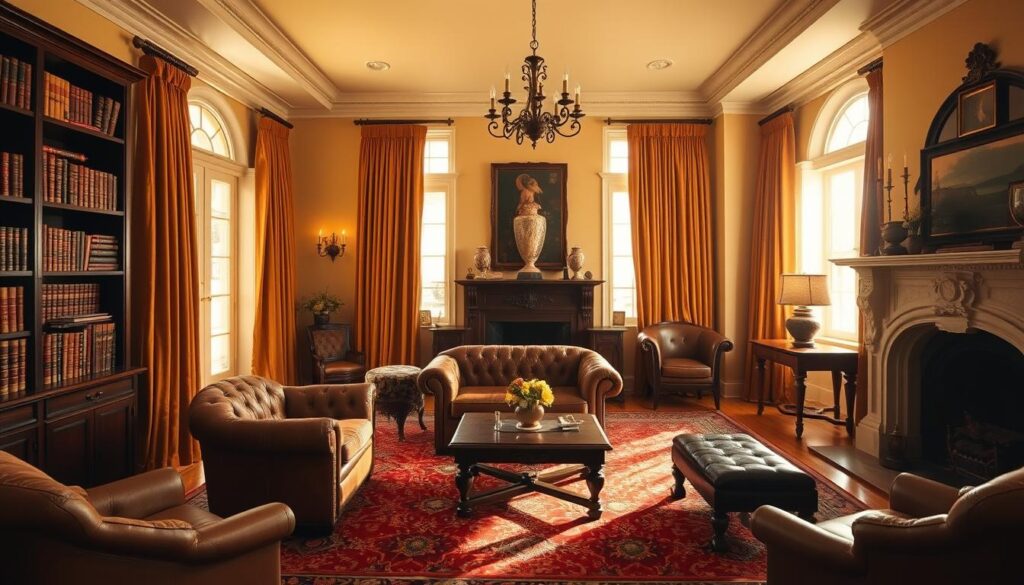
In conclusion, textiles are key in colonial style. They add warmth and character to a space. By picking the right fabrics and patterns, you can create a beautiful, historically inspired interior.
Accessorizing Your Colonial Home
Accessorizing is the final touch for a colonial-style home. It adds warmth and elegance. The right accessories can really bring out the classic colonial architecture.
Wall Decor: Art and Frames
Choosing the right art and frames is key for wall decor. Traditional colonial homes often have classic artwork in ornate frames. Frames that match your home’s style are important. Gold or wooden frames can add sophistication and authenticity.
“The right frame can make a piece of art stand out,” says interior designer, Jane Smith. “In colonial homes, we see elaborate frames that show off the era’s craftsmanship.”
Lighting Choices: Fixtures That Fit
Lighting is crucial for accessorizing a colonial home. The right fixtures can enhance the ambiance and highlight your home’s architecture. Chandeliers, sconces, and candelabras are great for colonial homes, adding warmth and elegance.
- Candelabras and candlesticks add authenticity.
- Sconces provide light and decoration.
- Chandeliers can be a stunning centerpiece in dining or living rooms.
By picking the right wall decor and lighting, you can make your colonial home beautiful and true to its history.
Incorporating Modern Touches in Colonial Design
Mixing the classic look of colonial style with modern elements can make a home truly special. When you’re updating a colonial home, finding the right balance is key. You want to keep its traditional charm while adding modern touches.
Updating a colonial home can be tricky. You need to keep its historical feel while making it modern and useful. This is done by carefully adding modern elements to the existing design.
Blending Contemporary Elements
To mix modern elements with traditional colonial design, try these tips:
- Change lighting fixtures to modern styles but keep traditional looks elsewhere.
- Add modern furniture that fits with the colonial style.
- Use new textiles and patterns in small amounts to add interest.
For example, a sleek, low-profile sofa in rich leather can update a living room. At the same time, traditional wooden accents keep the colonial charm.
Maintaining Character While Updating
When updating a colonial home, keeping its original character is important. This means:
- Fixing original features like hardwood floors and moldings.
- Picking modern elements that match the home’s traditional style.
- Avoiding big changes that could harm the home’s history.
A well-thought-out renovation can make a colonial home even more elegant. Here’s a table with some key points:
| Design Element | Traditional Colonial | Modern Update |
|---|---|---|
| Furniture | Ornate, carved wood | Sleek, minimalist designs |
| Color Scheme | Muted, earthy tones | Bold accents, neutral backgrounds |
| Lighting | Candelabras, chandeliers | Recessed lighting, modern fixtures |
By carefully mixing modern touches with traditional colonial design, homeowners can create a unique and elegant space. This space honors the home’s history while feeling modern and functional.
Landscaping for Colonial Style Homes
A well-designed landscape can make your colonial home look even better. The outside of your home is just as important as the inside. Landscaping is key to making your home look great.
Designing the Exterior to Match
To make your home’s exterior look good, choose a landscape that fits its colonial style. Pick plants, hardscapes, and other features that match colonial-era gardens. Symmetry is important, using balanced beds, paths, and garden features.
For plants, go for boxwood, hydrangeas, and roses, popular in colonial times. These plants add history and beauty to your garden.
Colonial Gardens: Character and Function
Colonial gardens were beautiful and useful, growing herbs, veggies, and medicines. Think about adding a kitchen garden or herb garden to your design. They add character and usefulness to your yard.
Colonial gardens were also meant to look good. They had geometric shapes, fountains, and statues. Adding these features makes your garden beautiful and historically inspired.
Designing your landscape to match your home’s colonial style can make it more charming. It creates a look that reflects the classic colonial architecture.
Tips for Achieving Balance in Colonial Interiors
Creating balance in colonial interiors is an art. It needs a deep understanding of traditional design. When done right, it makes a space feel elegant yet welcoming.
Symmetry and Design Principles
Symmetry is key in colonial interior design. It means making both sides of a central point look alike, often around a fireplace or doorway. This balance is achieved by arranging furniture, lighting, and decor evenly.
For example, if you have a big sofa on one side, place something similar or decorative on the other. This balance brings order and stability, typical of colonial homes.
Creating Cohesive Spaces
Making spaces cohesive means all elements work well together. This includes picking a consistent color scheme, furniture that matches, and textiles that enhance the look.
Think about the style and era of your furniture and decor. For colonial homes, choose traditional pieces like Queen Anne or Chippendale. Also, classic patterns like damask or toile add depth and character.
By focusing on symmetry, design principles, and cohesive spaces, you can create a balanced colonial interior. It will be stylish and inviting.
Maintaining Your Colonial Style Decor
To keep your colonial-style home looking its best, regular maintenance is key. We’ve covered many aspects of colonial home decorating tips. This includes choosing the right furniture and adding traditional colonial design elements.
For classic furnishings, routine care is vital. This means dusting, polishing, and protecting delicate surfaces. For example, use a soft cloth to dust intricate carvings. Also, apply furniture wax to keep the finish looking good.
Caring for Antique Pieces
When dealing with antique pieces, gentle cleaning is essential. Avoid harsh chemicals that can harm the material. If an item is very valuable or sensitive, consider getting a professional’s help.
Updating with Timeless Elegance
Updating your colonial decor doesn’t mean losing its charm. Adding subtle modern touches, like new textiles or lighting, can refresh your space. This way, you keep its classic character.
By following these tips and staying true to traditional colonial design, you can have a beautiful, timeless home. It will reflect your personal style perfectly.

